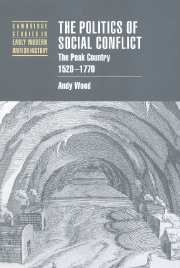Book contents
- Frontmatter
- Contents
- List of figures
- List of tables
- List of maps
- Preface
- List of abbreviations
- Introduction ‘Terms we did not understand’: landscape, place and perceptions
- 1 Social relations and popular culture in early modern England
- Part I The structures of inequality
- Part II The conditions of community
- Part III The politics of social conflict
- 9 ‘Pyllage uppon the poore mynorz’: sources of social conflict, 1500-1600
- 10 ‘All is hurly burly here’: local histories of social conflict, 1600-1640
- 11 The peak in context: riot and popular politics in early Stuart England
- 12 ‘Prerogative hath many proctors’: the English Revolution and the plebeian politics of the Peak, 1640–1660
- 13 The experience of defeat? The defence of custom, 1660–1770
- 14 The making of the English working class in the Derbyshire Peak Country
- Bibliography
- Index
- Cambridge Studies in Early Modern British History
11 - The peak in context: riot and popular politics in early Stuart England
Published online by Cambridge University Press: 27 July 2009
- Frontmatter
- Contents
- List of figures
- List of tables
- List of maps
- Preface
- List of abbreviations
- Introduction ‘Terms we did not understand’: landscape, place and perceptions
- 1 Social relations and popular culture in early modern England
- Part I The structures of inequality
- Part II The conditions of community
- Part III The politics of social conflict
- 9 ‘Pyllage uppon the poore mynorz’: sources of social conflict, 1500-1600
- 10 ‘All is hurly burly here’: local histories of social conflict, 1600-1640
- 11 The peak in context: riot and popular politics in early Stuart England
- 12 ‘Prerogative hath many proctors’: the English Revolution and the plebeian politics of the Peak, 1640–1660
- 13 The experience of defeat? The defence of custom, 1660–1770
- 14 The making of the English working class in the Derbyshire Peak Country
- Bibliography
- Index
- Cambridge Studies in Early Modern British History
Summary
REDEFINING PUPULAR POLITICS
The historiography of so-called ‘protest movements’ has often been informed by a mechanistic economism. Like the histories of Luddism, the rise and decline of Chartism, and support for the organized socialist and labour movements of the early twentieth century, ‘upsurges’ of early modern popular protest have sometimes been interpreted as the product of ‘crisis’ years in, for instance, the late 1540s, the mid-1590s and the late 1620s. It is certainly true that dearth, population pressure and inflation often formed the backdrop to enclosure and food riots, planned and actual insurrections, and to the seditious mutterings transcribed in countless court papers. But social conflict in early modern England cannot be explained by economic pressure alone. Otherwise, national periods of economic crisis should have provoked a uniform pattern of popular protest across the country. Instead, historians of riot and protest in early modern England have repeatedly made the point that disorder was typically local or, at best, regional in character. That point is usually made in order to emphasize the allegedly conservative, limited nature of protest. Such a reading of local social conflicts is, at best, only two-dimensional.
Early modern plebeian politics were typically produced out of local cultures and local contexts. That relationship was a circular one, driven by the dynamic of social conflict. Political engagement in turn altered local identities and refashioned social collectivities, thereby both reproducing and refashioning local cultures.
- Type
- Chapter
- Information
- The Politics of Social ConflictThe Peak Country, 1520–1770, pp. 249 - 266Publisher: Cambridge University PressPrint publication year: 1999



